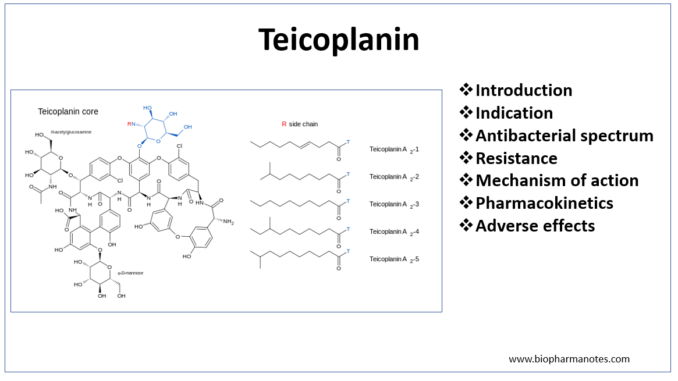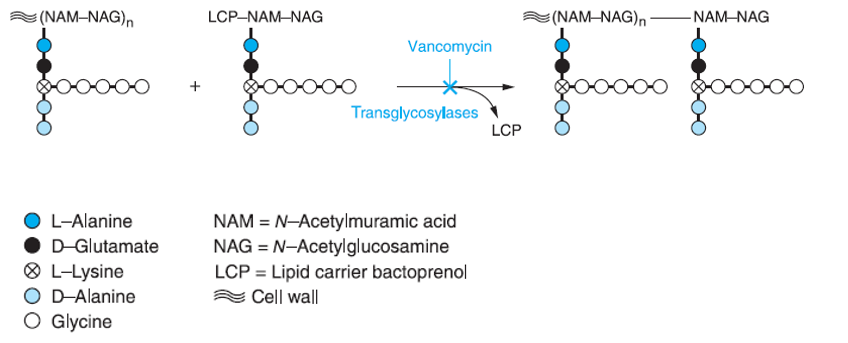
- Teicoplanin is glycopeptide antibiotic which consist of mixture of several compounds. Five are major compounds named teicoplanin A2-1 to A2-5 and four are minor compounds named teicoplanin RS-1 through RS-4. All teicoplanin have same glycopeptide core A3-1 but have different length and confirmation of side chains.
- It is produced by Actinoplanes teicomyetius. It is structurally related to vancomycin and have similar mechanism of action, antibacterial spectrum and renal elimination as of vancomycin.
Indications of teicoplanin
- Used to treat enterococcal endocarditis (along with gentamicin).
- Used to treat MRSA (Methicillin resistant Staphylococcus Aureus) and penicillin resistant streptococcal infections.
- It is used as alternative to vancomycin for surgical prophylaxis
Anti- bacterial spectrum of teicoplanin
- It is mainly active against gram- positive bacteria including staphylococci, streptococci and enterococci. It has bactericidal effect against susceptible strains except for enterococci. Teicoplanin is effective against methicillin susceptible and methicillin resistant staphylococci, Corneybacterium spp., Clostridium spp., and anaerobic gram +ve bacteria. However, it has less efficacy than antistaphylococcal penicillin in treating severe infections caused by methicillin susceptible organisms.
- It is not effective against gram- negative bacteria, mycobacteria or fungi.
Resistance
- There is increasing emergence of teicoplanin resistant strains of bacteria. Prolonged or inappropriate treatment with vancomycin can lead to development of resistance. The resistance may be due to plasmid mediated alteration of dipeptide target site which reduces its affinity for teicoplanin.
- Some strains of coagulase positive and coagulase negative staphylococci and some strains of enterococci, which are intrinsically resistant to vancomycin also show intrinsic resistance to teicoplanin.
Mechanism of action of teicoplanin

Figure- Mechanism of action of teicoplanin is similar to that of vancomycin. Both acts by inhibition of bacterial cell wall synthesis. (Figure source- Goodman and Gillman Manual of Pharmacology)
- It exerts its bactericidal effect by inhibiting cell wall synthesis. Peptidoglycan are major structural component of gram- positive bacterial cell wall. It binds to terminal dipeptide (D-ala- D-ala) sequence of peptidoglycan precursor unit i.e. NAM (N- acetyl muramic acid) and NAG (N- acetyl glucosamine). Then it prevents incorporation of NAM and NAG subunits into peptidoglycan matrix. Hence, it inhibits bacterial cell wall synthesis.
Pharmacokinetics
- It is administered safely through IM route. It shows poor bioavailability when administered through oral route.
- Teicoplanin is highly bound to plasma proteins (about 90%). It has prolonged serum half-life of around 100 hours in patients with normal renal function. Hence, once daily dosing is used in most cases. Dose adjustment is required in patients with impaired renal function. In case of functionally anephric patients, one dose per week is preferred and serum drug concentration need to be monitored regularly.
- It rapidly penetrates into tissues. High concentration is found in kidney, trachea, lungs and adrenal. It shows poor penetration into cerebrospinal fluid. Most of the drug is excreted unchanged by kidney.
Adverse effects
- It is considered to be safer compared to vancomycin. The incidence of adverse effects and nephrotoxicity are more with vancomycin than teicoplanin.
- Its main side effect is rash which is dose related. It has potential to cause ototoxicity and nephrotoxicity. However, the chances are rare if recommended serum concentration are maintained. Some other side effects are fever and granulocytopenia.
References
- Khamesipour F et al. A Review of Teicoplanin Used in the Prevention and Treatment of Serious Infections Caused by Gram-Positive Bacteria and Compared Its Effects with Some other Antibiotics. Biomed Pharmacol J 2015;8(1).
- Richards DMC et al. Teicoplanin. A review of its antibacterial activity, pharmacokinetic properties and therapeutic potential. Drugs. 1990 Sep;40(3):449-86.
- Mandell, Douglas, and Bennett’s Principles and Practice of Infectious Diseases Book. Eighth Edition.
- Infectious Diseases of the Fetus and Newborn. Seventh Edition.
- Pharmacology and pharmacotherapeutics. 24th edition.
- Goodman and Gillman Manual of Pharmacology and Therapeutics.
- Essentials of Medical Pharmacology. 7th edition.
- https://go.drugbank.com/drugs/DB06149